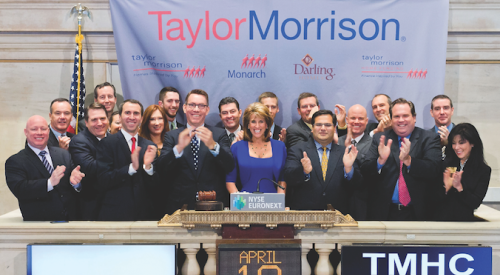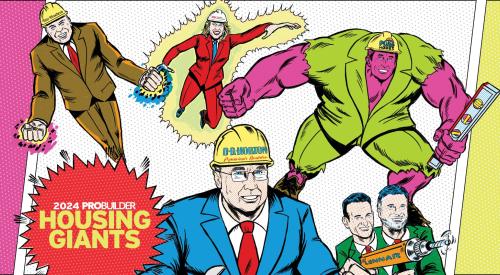|
|||||||||||||||||||||
A year ago, the chief executives of the industry’s 400 largest home builders tried hard to keep a lid on their optimism. In the face of a weakening economy it seemed foolish to do otherwise. Every previous economic downturn had hurt builders acutely, particularly the Giants, many of whom remember being caught flat-footed from 1986 to ’91, when U.S. home building starts fell 45%. The refrain from Giants executives last year was, “This time is different.”
They could not have been more correct. Today, with a broad economic recovery later this year in sight, big home builders are masters of the universe. They lead an industry that is leading the economy out of its doldrums. And considering the uncertainty of the past 12 months, housing’s Giants are developing the swagger of modern St. Georges out to slay the housing-cycle dragon. In the words of housing analyst Greg Nejmeh of Deutsche Banc Alex. Brown, “Housing cyclically has indeed been substantially tempered.” Which was very good news for the uber-Giants in 2001.
Bigger
For the seventh consecutive year, the Giant 400 captured a larger share of the nation’s 1.57 million-unit housing pie. Representing 32.6% percent of closings, the Giant 400 in 2001 was within a hair’s breadth of an impressive benchmark. Nearly a third of all new homes were built and sold by Giants last year.
This growing market share by the industry’s largest companies is so steady and strong that it is fueling debate about how big the biggest eventually will be and how quickly it might happen. Some, such as researchers at Andersen Corporate Finance LLP, forecast a quick consolidation of the new home market. The Andersen report predicts that up to 75% of all housing activity will be conducted by as few as 20 companies in 2011 (see Point-Counterpoint). While this view might be extreme, there is no mistaking the consistent trend, particularly among the Giants that fill out the first 20 spots.
Last year, consolidation to this group meant not only mega-mergers, namely Pulte and Del Webb, but also a series of combinations characterized by their Pac-Man-like aspect. Technical Olympic merged Engle Homes and Newmark Homes under its banner. D.R. Horton bought Emerald Builders and then agreed to acquire Schuler Homes just after Schuler had purchased Western Pacific Housing. K. Hovnanian Enterprises bought Washington Homes of Maryland before going after an even bigger fish, The Forecast Group, agreeing to a merger the rankings won’t reflect until next year. Another billion-dollar company in on the Pac-Man act was Beazer Homes USA, which followed its purchase of Sanford Homes of Colorado with an agreement to acquire Crossman Communities.
This much seems clear: With a top five of Lennar Corp., Pulte Homes, Centex Corp., D.R. Horton and KB Home, the upper echelon of the Giant 400 looks to be settling in for a while. Most of these companies have merged with their complementary Giant counterpart to address strategic needs — active-adult specialists merging with conventional production builders and so forth. So if the top continues to grow as predicted, it likely will be a result of fewer mergers among Giant equals and more outright acquisitions of companies below the billion-dollar threshold.
Better
Hard to ignore are the growing differences among major groups within the Giant 400. From companies with huge operations that go coast to coast with name brands to robust niche operators operating in single markets, the unifying thread is profit and how best to increase it. Giants, more than any other builders, know this to be the chief benefit of being big.
The 400 Giants have an average profit margin of 8.6%. But divide them into four groups and average their profit margins, and the benefits of size become clearer. Giants ranked from 276 through 400 ($56 million in revenue or less) had an average profit margin of 7.65%. Those ranked from 126 to 275 (revenue of $145 million to $56 million) had an average profit margin of 9.04%. Giants ranked from 21 to 125 (with a revenue range from $906 million to $145 million) had profit margins averaging 9.22%. Most stunning is the advantage among the top 20. They achieved an 11.76% average profit margin.
The drive for enhanced profitability among all Giants is also revealed in the opportunities they see today: market expansion, exploring niche markets and incorporating new operational efficiencies. On the flip side, land, regulations and labor remain top concerns for these booming builders as well.
Stronger
Home builders are stronger as a group thanks to lessons learned from past downturns. Perhaps these lessons are enabling the sector’s continued strength through shaky economic times. Much of the credit this time must go to changes that have come from outside the industry. Regulatory reforms have curbed the excesses of past boom-time lending. Liquidity in the mortgage market has pushed homeownership levels to record rates. And most of all, the Federal Reserve has kept interest rates low.
But builders deserve credit, too — a subject we will examine in detail in this year's Giants report.












